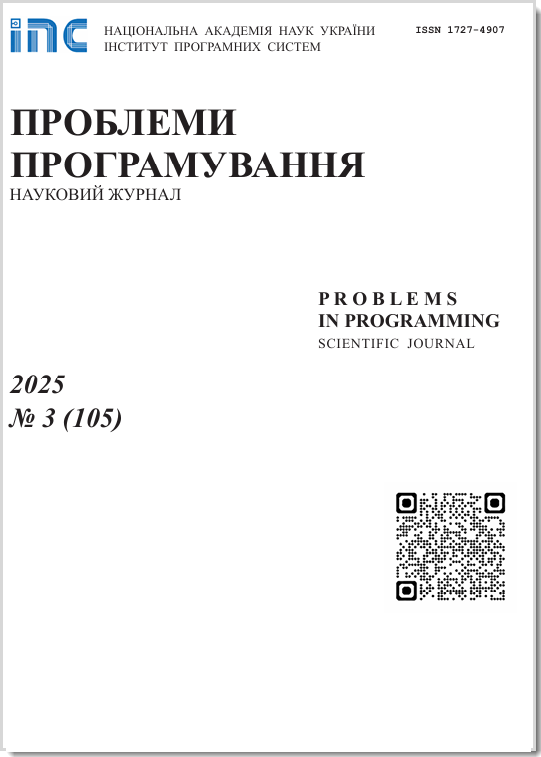Methods and tools for developing an information system for validation of non-formal learning outcomes
Abstract
The publication describes methods and tools for development an information system (IS) for acceptance of the non-formal and informal learning results on base of computer ontologies. ESCO ontology of the multilingual skills classifier is used as a prototype of domain ontology that provides knowledge for developed IS. We propose the main stages of development of IS for validation of the results of non-formal learning that include creation of an ontology schema, process of integration of the obtained ontology into the RDF repository, development of application architecture and creation of user interface.
The modern approaches to design and development of knowledge-oriented distributed applications intended for functioning in the open Web environment are analyzed, the existing methods and software tools for the presentation and analysis of knowledge and their suitability for solving the task are considered. We propose an innovative method of IS development based on the use of such elements of the Semantic Web project as ontologies, Web services and software agents.
The paper describes the tools used in process of development of IS for validation of non-formal learning outcomes. In particular, we analyse Neo4j database management system serving the GraphDB database, the specifics of connectors and SPARQL requests to the data stored in the RDF repository and the tools used for web server creation. Comparison of PHP frameworks for web applications is performed in consideration of task requirements.
Functional modeling of IS in order to determine its main functionalities is performed, and the DFD data flow diagrams of system are designed. The benefits of Laravel software are established on base of the analysis of such criteria as security, readiness to installation of plugins and libraries, support for the MVC (Model-View-Controller) concept. User interface is developed to ensure user dialogue with IS. Authers analyse software tools oriented on development of user interface and select React framework that works efficiently with all software tools selected for IS development on the previous stages of analysis.
Problems in programming 2020; 2-3: 50-60
Keywords
Full Text:
PDF (Українська)References
Pryima S. & Rogushina J. Semantic processing of information resources in the market. Information technology and training tools. 2018. Vol. 65. N 3. P. 337-355. (in Ukrainian). CrossRef
Sheila A. & Mcilraith Tran Cao Son & Honglei Zen. Semantic Web Services, Stanford University. URL: http://www.ksl.stanford.edu (дата звернення: 26.02.2020).
Pryima S., Rogushina J. Development of methods for support of qualification frameworks transparency based on semantic technologies. Information Technologies and Learning Tools. 2017. Vol. 59. N 3. Р. 201-210. (in Ukrainian). CrossRef
Pryima S., Rogushina J. Ontological approach to qualifications matching on base of competences: model and methods. Науковий вісник НГУ. 2017. N 6. P. 162-168. Available from: http://www.nvngu.in.ua/jdownloads/pdf/2017/06/06_2017_Rogushina.pdf
Davies J. & Fensel D. & van Harmelen F. Towards the Semantic Web: Ontology-driven knowledge management . John Wiley & Sons Ltd, England. 2002. 288 p. (in England). CrossRef
Rogushina J., Priyma S. Use of competence ontological model for matching of qualifications. Chemistry: Bulgarian Journal of Science Education. 2017. Vol. 26. N 2. P. 216-228. (in Bulgariа)
Pryima S.M., Rohushyna Yu.V., Strokan' О.V. Use of semantic technologies in the process of recognizing the outcomes of non-formal and informal learning. CEUR Workshop Proceedings. 2018. Vol. 2139. P. 226-235. (in Ukrainian). Available from: http://ceur-ws.org/Vol-2139/226-235.pdf
Zaripov A. & Tuzovskiy A. Development of a metadata storage system for semantic information system. Institute of Cybernetics of National Research Tomsk Polytechnic Institute. Tomsk, 2010. Р. 53-58. in Russian).
Horrocks I., Patel-Schneider P., van Harmelen F. From SHIQ and RDF to OWL: The making of a Web Ontology Language. Web Semantics: Science, Services and Agents on the World Wide Web. 2003. P. 7-26.CrossRef
OWL Web Ontology Language. Overview. W3C Recommendation: W3C, 2009. URL: http://www.w3.org/TR/owl-features/ (дата звернення: 22.02.2020).
OWL 2 Web Ontology Language Document Overview. W3C. 2009. URL: http://www.w3.org/TR/owl2-overview/ (дата звернення: 24.02.2020).
Tim Berners-Lee, James Hendler and Ora Lassila. The Semantic Web URL:http://www.sciam.com/article.cfm?articleid=000A0919 (дата звернення: 26.02.20. 20).
Shenchenko YE. & Shenchenko A. & Bogdan. Features of the construction of applied software systems based on ontological knowledge bases. ACS and automation devices: all-in. inter. scientific and technical Sat. Kharkiv: Publishing House of KNURE. 2011. Vol. 157. P. 36-41. (in Ukrainian).
Angular.URL:https://uk.wikipedia.org/wiki/Angular_(%D1%84%D1%80%D0%B5%D0%B9%D0%BC%D0%B2%D0%BE%D1%80% D0%BA) (дата звернення: 22.02.2020).
Vue.js. URL: https://uk.wikipedia.org/wiki/Vue.js (дата звернення: 22.02.2020).
DOI: https://doi.org/10.15407/pp2020.02-03.050
Refbacks
- There are currently no refbacks.




